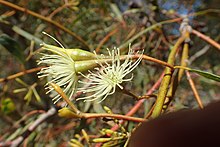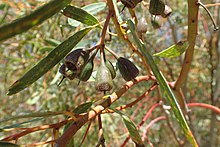| Salt River gum | |
|---|---|

| |
| Eucalyptus sargentii near Hyden | |
| Scientific classification | |
| Kingdom: | Plantae |
| Clade: | Tracheophytes |
| Clade: | Angiosperms |
| Clade: | Eudicots |
| Clade: | Rosids |
| Order: | Myrtales |
| Family: | Myrtaceae |
| Genus: | Eucalyptus |
| Species: | E. sargentii |
| Binomial name | |
| Eucalyptus sargentii Maiden | |


Eucalyptus sargentii, commonly known as Salt River gum, is a species of mallet, mallee or small tree that is endemic to Western Australia. It has rough bark on part or all of the trunk, smooth bark above, linear to narrow lance-shaped leaves, flower buds in groups of seven, whitish to creamy yellow flowers and conical fruit.
Description
Eucalyptus sargentii is a tree or a mallee that typically grows to a height of 3–12 m (9.8–39.4 ft) but does not usually form a lignotuber (a mallet). It has smooth greenish bark that is brownish when new, usually with rough, greyish flaky bark on part or all of the trunk. Adult leaves are arranged alternately, the same shade of green on both sides, linear to narrow lance-shaped or curved, 53–126 mm (2.1–5.0 in) long and 5–13 mm (0.20–0.51 in) wide tapering to a petiole 5–18 mm (0.20–0.71 in) long. The flower buds are arranged in leaf axils in groups of seven on an unbranched peduncle 7–20 mm (0.28–0.79 in) long, the individual buds on pedicels 3–6 mm (0.12–0.24 in) long. Mature buds are an elongated oval shape, 16–26 mm (0.63–1.02 in) long and 4–5 mm (0.16–0.20 in) wide with a horn-shaped operculum that is about twice as long as the floral cup. Flowering occurs from August or October to December or January and the flowers are whitish to creamy yellow. The fruit is a woody conical capsule 6–9 mm (0.24–0.35 in) long and 5–8 mm (0.20–0.31 in) wide with the valves near rim level.
Taxonomy and naming
Eucalyptus sargentii was first formally described in 1924 by Joseph Maiden in his book A Critical Revision of the Genus Eucalyptus. The specific epithet honours Oswald Hewlett Sargent, a pharmacist and naturalist from York.
In 1992, Lawrie Johnson and Ken Hill described E. sargentii subsp. fallens and E. sargentii subsp. sargentii but only the autonym is accepted by the Australian Plant Census (APC). In 2005, Dean Nicolle described E. sargentii subsp. onesis and the name is accepted by the APC. Subspecies onesis differs from the autonym in having a lignotuber and a dense, spreading mallee habit. The name onesis is from an ancient Greek word meaning "advantage" or "use", referring to the potential use of this subspecies in reclaiming saline sites.
Distribution and habitat
Salt River gum grows in open woodland in low-lying, poorly drained areas near salt lakes and salt creeks. It has a scattered distribution from Pithara to Lake Grace in the Avon Wheatbelt biogeographic region. Subspecies onesis is restricted to seven populations between Piawaning, York and Cunderdin.
Conservation status
Subspecies sargenti is classified as "not threatened" by the Western Australian Government Department of Parks and Wildlife, but subspecies onesis is classified as "Priority Three" by the Government of Western Australia Department of Parks and Wildlife meaning that it is poorly known and known from only a few locations but is not under imminent threat.
See also
References
- "Eucalyptus sargentii". Australian Plant Census. Retrieved 18 December 2019.
- ^ "Eucalyptus sargentii". FloraBase. Western Australian Government Department of Biodiversity, Conservation and Attractions.
- "Plants of the World Online | Kew Science". Plants of the World Online. Retrieved 2024-02-01.
- ^ "Eucalyptus sargentii subsp. sargentii". Euclid: Centre for Australian National Biodiversity Research. Retrieved 29 May 2020.
- ^ Chippendale, George M. "Eucalyptus sargentii". Australian Biological Resources Study, Department of the Environment and Energy, Canberra. Retrieved 18 December 2019.
- "Eucalyptus sargentii". APNI. Retrieved 18 December 2019.
- Maiden, Joseph (1924). A Critical Revision of the Genus Eucalyptus. Sydney: New South Wales Government Printer. pp. 58–60. Retrieved 18 December 2019.
- "Sargent, Oswald H. (1880 - 1952)". Council of Heads of Australasian Herbaria Australian National Herbarium. Retrieved 18 December 2019.
- Johnson, Lawrence A.S.; Hill, Kenneth D. (1992). "Systematic studies in the eucalypts. 5. New taxa and combinations in Eucalyptus (Myrtaceae) in Western Australia". Telopea. 4 (4): 573–575. Retrieved 31 October 2021.
- "Eucalyptus sargentii subsp. sargentii". Australian Plant Census. Retrieved 18 December 2019.
- ^ Nicolle, Dean (2005). "A rare and endangered new subspecies of Eucalyptus sargentii (Myrtaceae) with high potential for revegetation of saline sites from south- western Australia and notes on E. diminuta and E. sargentii subsp. fallens" (PDF). Nuytsia. 15 (3): 396–399. Retrieved 18 December 2019.
- "Eucalyptus sargentii subsp. onesis". Australian Plant Census. Retrieved 18 December 2019.
- Francis Aubie Sharr (2019). Western Australian Plant Names and their Meanings. Kardinya, Western Australia: Four Gables Press. p. 372. ISBN 9780958034180.
- "Eucalyptus sargentii subsp. sargentii". FloraBase. Western Australian Government Department of Biodiversity, Conservation and Attractions.
- "Conservation codes for Western Australian Flora and Fauna" (PDF). Government of Western Australia Department of Parks and Wildlife. Retrieved 18 December 2019.